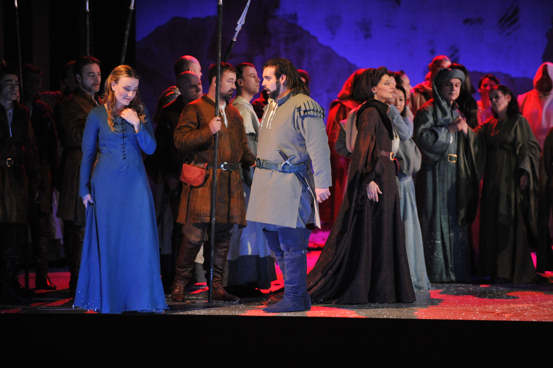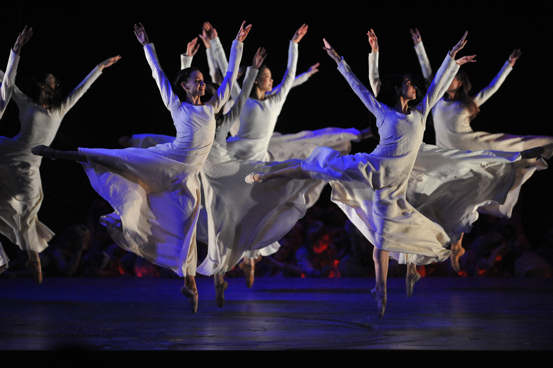Other Links
Editorial Board
-
Editor - Bill Kenny
-
London Editor-Melanie Eskenazi
-
Founder - Len Mullenger
Google Site Search
SEEN
AND HEARD INTERNATIONAL OPERA REVIEW
Gounod, Faust :
Soloists,
Orchestre, Chorus and Ballet de l’Opera National de Bordeaux.
Conductor: Emmanuel Joel-Hornak. Grand Théâtre de Bordeaux. 16.
3.2008 (JMI)
Attending a performance of Gounod’s Faust in France should
be - and in fact is - almost a guarantee of having a complete
version, including the ballet, which is more than justified in
this opera. It seems that the Director of the Opera of Bordeaux,
Thierry Fouquet, considered this Faust one of the most
important in this opera season, since he commissioned a new
production. Setting the opera in medieval times, he decided to
offer an integral version of the opera, and finally he presented
two different casts with two young tenors who both can be
considered as really promising. Perhaps the most original aspect
of this Faust has consisted reinstating the scenes in the
order that they had at its premiere in Paris, placing the
Church scene after the death of Valentin. Apparently the tradition
to offer the Church scene before Valentin’s death began with the
first performance of at Paris Opera- the original premiere took
place in Paris, but at Théâtre Lyrique - to achieve greater
dramatic impact. This is the first time that I have
seen it like this and I do not know any recording in
which the scenes follow this original sequence. Despite the
established tradition and impact, it seems to me a praiseworthy
effort to return to the origin, since this is what both Gounod and
Goethe wrote.
Musical direction was entrusted of Emmanuel Joel-Hornak, who
offered a sound version of the opera, remarkably better in the
dramatic passages that in the more intimate ones. His reading was
a little flat in the first act, conducting with determination the
Walpurgis night ballet music and there were problems of tempo
between Mephistopheles and the pit during Le Veau d’Or. Overall
however, M. Joel-Hornaka drew
good performance from the orchestra. The ballet was the highlight of the afternoon,
shining better as an ensemble than particular individuals
did.
New production:
Directors: Jean-Philippe Clarac and Olivier Deloeuil
Sets: Philippe Miesch
Costumes: Thibaut Welchlin
Lighting: Giuseppe di Iorio
Choreography: Charles Jude
Cast:
Faust: Dimitri Pittas
Marguerite: Michelle Canniccioni
Mephistophélès: Alain Vernhes
Valentin: David Grousset
Siebel: Marie Lenormand.

The new production has been commissioned from two natives of
Bordeaux, Jean-Philippe Clarac and Olivier Deloeuil, who are
the artistic directors of Opera Française of New York just
now. As I said above, the action takes place in the Middle Ages.
The production is very simple in terms of staging, since the
sets hardly consist of anything more than a painted backdrop
for the first half and another in black for the second. The rest
of the elements is somewhat figurative, showing a cemetery in the
first act (Faust studies i corpses), a very attractive Holy Lamb (?Le Veau d’Or
)
in the kermesse. The sets for Act IV are very poor,
improving much for Walpurgis Night, returning to a bare stage with
a cage, in which Marguerite is imprisoned. One interesting
idea is the appearance of some angels at the beginning of the
opera, who reappear at the end to take Marguerite to heaven. There
is no particularly noteworthy direction of actors nor much
movement for the ensemble as a whole. While one can
expect some touches of originality in a new production this
pfermonace had one of the most absurd I have ever seen on stage.
At the end of Act III, when Marguerite comes to her window and
sings “Cher bien-aimé, viens!”, she exposes and and caresses one
of her breasts, an unequivocal signal that the good doctor
understands immediately.

Faust was
sung by the young American tenor Dimitri Pittas, whose presence raised
some high expectations, after his recent Macduff at the
Metropolitan in New York. He is a lyric tenor with good presence,
a central register of good quality, a lower range far more sonorous than is
usual for this these voice type, and a top of that is not so
good.
He was a reliable interpreter, lacking a certain amount elegance in
“Salut, demeure (or garden) chaste et pure”, delivering a high C
with a kind of mixed-register voice. Unfortunately I could not stay in
Bordeaux to see Korean Woo Kyun Kim, who is for me one of the most
promising young tenors at the moment.
Michelle
Canniccioni was a sensitive Marguerite, who did not shine
particularly brightly in pure vocal terms. Her voice is lighter than the role requires and her vocal volume is
slightly too small - which
in this theater is not terribly important, given its size and
outstanding acoustics. Veteran
Alain Vernhes was a convincing Mephistophélès on stage. He is a
good actor, but in vocal terms he leaves something to be desired, with
a very sonorous voice but without much ability to sing softly. David
Grousset left a poor impression as Valentin on me, while Marie
Lenormand made a good Siebel; with a small voice, but a good
interpretation. In this version Siebel has much more to sing than
usuual, since her
duet with Marguerite in Act IV has been restored. In the
secondary roles both Jean-Marc Bonicel (Wagner) and Marie-Thérèse
Keller (Dame Marthe) were far better actors than singers.
This was the
first of the 10 performances and the house was full. As I said
above, the ballet had the biggest success and among the singers, the
greatest applause went to Alain Vernhes. I don't disagree
but should add that both
the conductor and the creative team of 8 people were warmly
applauded too.
José M Irurzun
Pictures © L’Opéra National de Bordeaux
Back
to Top
Cumulative Index Page
